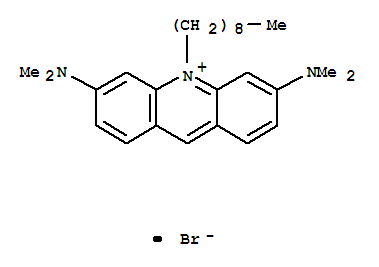| Identification |
| Name: | Acridinium,3,6-bis(dimethylamino)-10-nonyl-, bromide (1:1) |
| Synonyms: | Acridinium,3,6-bis(dimethylamino)-10-nonyl-, bromide (9CI); 10-nonyl acridine orange; A1372; Acridine Orange 10-nonyl bromide; Nonylacridine orange |
| CAS: | 75168-11-5 |
| Molecular Formula: | C26H38 N3 . Br |
| Molecular Weight: | 472.5 |
| Molecular Structure: |
 |
| Properties |
| Water Solubility: | DMSO: soluble |
| Solubility: | DMSO: soluble |
| Specification: |
usageEng:Nonyl acridine orange is well retained in the mitochondria of live HeLa cells for up to 10 days, making it a usefull probe for following mitochondria during isolation and after cell fusion. This dye has been used to analyze mitochondria by flow cytometry,
Safety Statements:26-36
26:In case of contact with eyes, rinse immediately with plenty
of water and seek medical advice
36:Wear suitable protective clothing |
| Storage Temperature: | 2-8°C |
| Usage: | Nonyl acridine orange is well retained in the mitochondria of live HeLa cells for up to 10 days, making it a usefull probe for following mitochondria during isolation and after cell fusion. This dye has been used to analyze mitochondria by flow cytometry, |
| Safety Data |
| Hazard Symbols |
 Xi: Irritant
Xi: Irritant
|
| |
 |